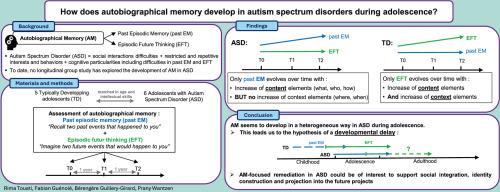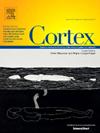Exploring the development of past and future episodic memory in adolescents with autism spectrum disorder: A preliminary longitudinal study
IF 3.2
2区 心理学
Q1 BEHAVIORAL SCIENCES
引用次数: 0
Abstract
Adolescence is a critical period where individuals build their identity and consolidate how they interact with others. However, for adolescents with autism spectrum disorder (ASD), the development of identity and social bounds is at stake. These challenges with the development of identity and social bonds could be linked to difficulties in autobiographical memory (AM), whether recalling past events (past episodic memory; past EM) or imagining future scenarios (episodic future thinking; EFT). To date, developmental patterns of AM over time remain poorly understood in ASD. Eleven adolescents with ASD or typical development (TD) completed an assessment of past EM and EFT once per year for three years. Preliminary results show that past EM becomes more detailed over the years for adolescents with ASD, while there is no change for TD adolescents. Interestingly, only the content elements of the narrated events are increasing, not the context elements. Furthermore, EFT evolves in the TD group but remains stable in the ASD group. This first multi-case longitudinal study of AM needs to be replicated with more participants, but it seems to indicate a heterogeneous evolution of AM in ASD. For future studies, these results will lead us to explore the hypothesis of developmental delay and the factors influencing AM development in ASD. Finally, understanding these developmental pathways highlights the importance of personalized therapeutic approaches to support social integration, identity construction, and future projects for adolescents with ASD.

探索自闭症谱系障碍青少年过去和未来情节记忆的发展:初步纵向研究
青春期是一个关键时期,在这一时期,每个人都要建立自己的身份认同,并巩固自己与他人的互动方式。然而,对于患有自闭症谱系障碍(ASD)的青少年来说,身份和社交关系的发展岌岌可危。这些身份和社交关系发展方面的挑战可能与自传体记忆(AM)方面的困难有关,无论是回忆过去的事件(过去外显记忆;past EM)还是想象未来的情景(外显未来思维;EFT)。迄今为止,人们对ASD患者的AM随时间的发展模式仍然知之甚少。11 名患有自闭症或典型发育(TD)的青少年在三年内每年完成一次对过去记忆和外显未来思维的评估。初步结果显示,患有自闭症的青少年在过去几年中的情绪管理变得更加详细,而患有典型发育障碍的青少年则没有变化。有趣的是,只有叙述事件的内容元素在增加,而背景元素没有增加。此外,EFT 在 TD 组中有所发展,但在 ASD 组中保持稳定。这项关于AM的首次多案例纵向研究还需要更多参与者的参与,但它似乎表明了ASD中AM的异质性演变。在未来的研究中,这些结果将引导我们探索 ASD 患者发育迟缓的假说以及影响 AM 发育的因素。最后,了解这些发展途径凸显了个性化治疗方法的重要性,以支持患有 ASD 的青少年的社会融合、身份构建和未来项目。
本文章由计算机程序翻译,如有差异,请以英文原文为准。
求助全文
约1分钟内获得全文
求助全文
来源期刊

Cortex
医学-行为科学
CiteScore
7.00
自引率
5.60%
发文量
250
审稿时长
74 days
期刊介绍:
CORTEX is an international journal devoted to the study of cognition and of the relationship between the nervous system and mental processes, particularly as these are reflected in the behaviour of patients with acquired brain lesions, normal volunteers, children with typical and atypical development, and in the activation of brain regions and systems as recorded by functional neuroimaging techniques. It was founded in 1964 by Ennio De Renzi.
 求助内容:
求助内容: 应助结果提醒方式:
应助结果提醒方式:


